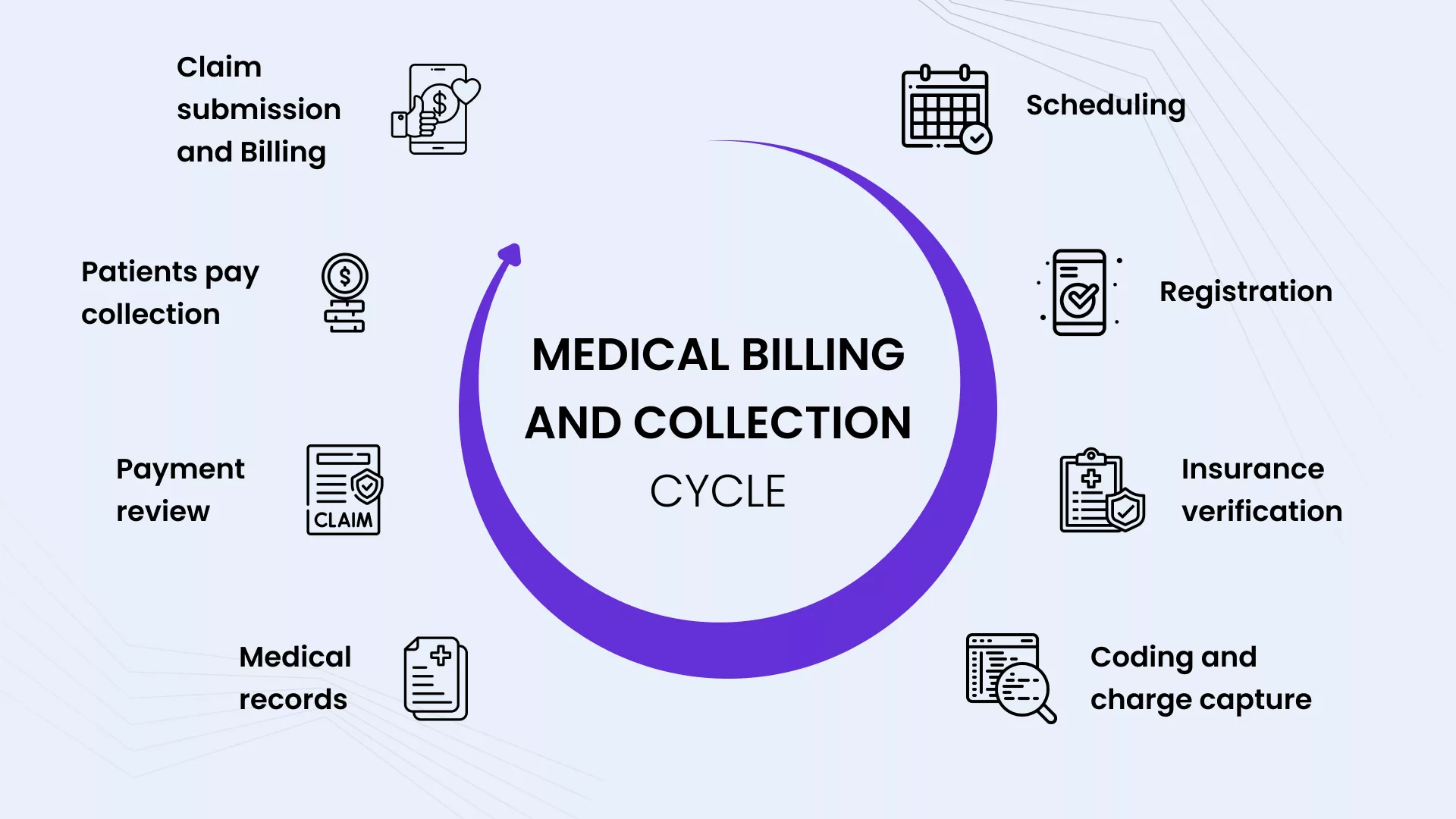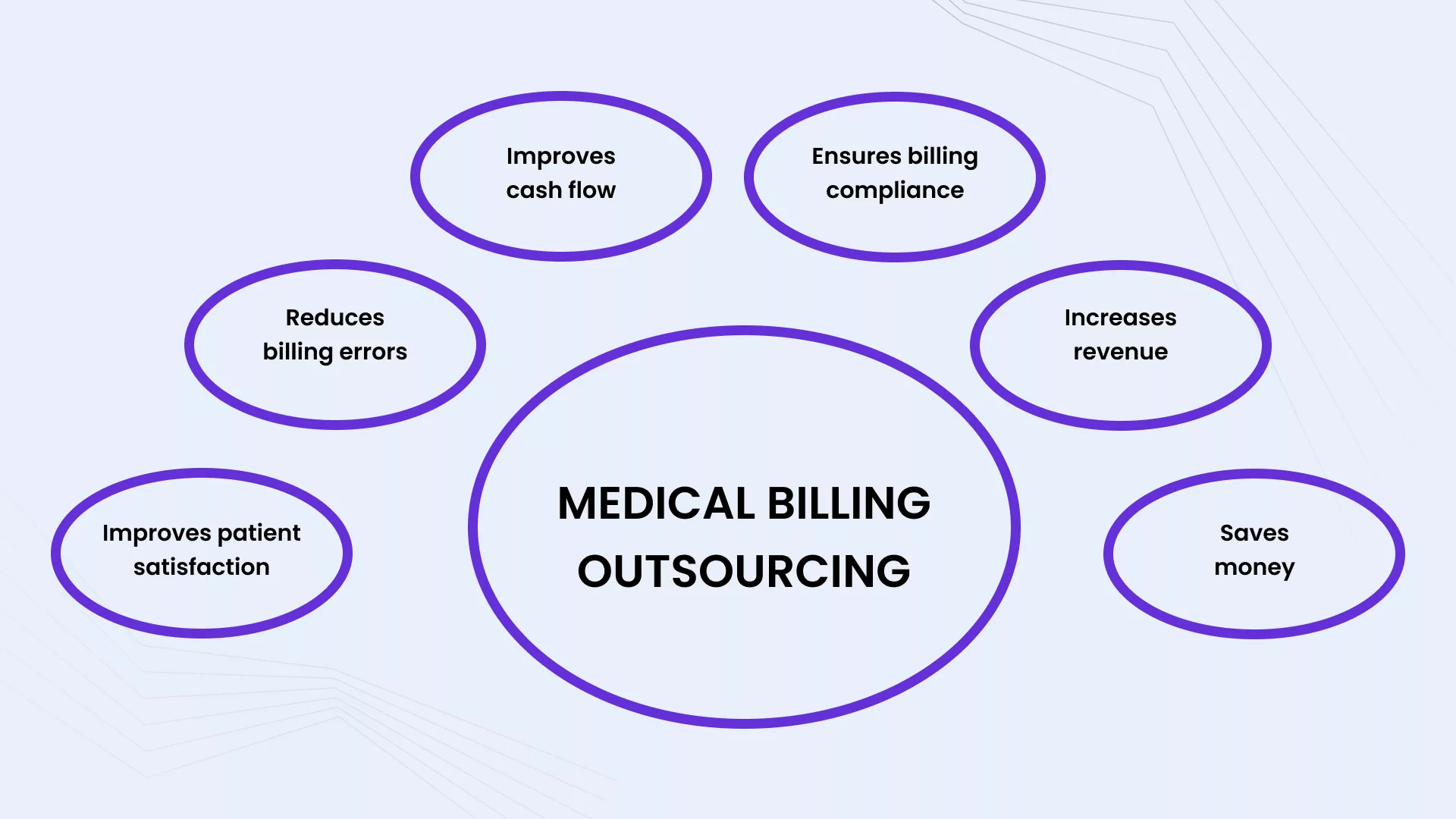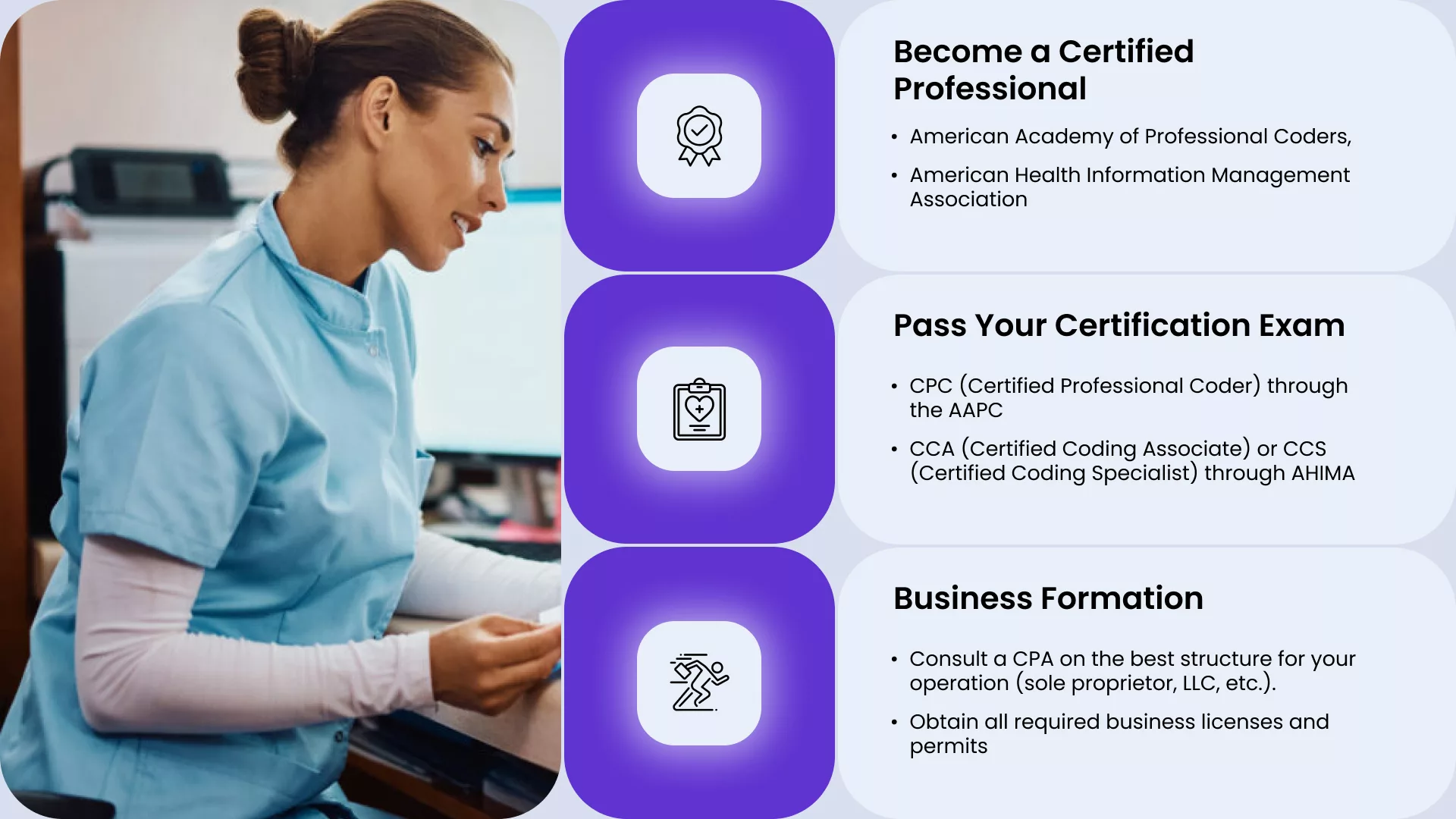Edited on 02.13.24.

Electronic billing and coding software streamlines the complex financial interactions between patients, healthcare providers, and insurance companies. Demand skyrockets, prompting entrepreneurs and developers to explore opportunities in this thriving sector. MWDN is a key player, with projects like Nicas CS showcasing our healthcare software expertise. Let’s dive into what it takes to succeed in this space.
Content:
- Step one: Market analysis
- How much does it cost to start a medical billing business?
- The software essentials for your medical billing business
- Building your development team
- Academic steps that will take you to a medical coding company
- Your roadmap to creating a medical billing and coding company
- How do you charge your clients?
- What’s new in medical billing and coding in 2024?
- Summing up
The US healthcare system is notoriously complex, demanding strict adherence to numerous medical billing regulations. To stay operational, you’ll need government certifications and prioritize robust data security to protect your clients and their patients.
Who are your clients? Medical billing is a business-to-business market. Your software simplifies reimbursement processes for diverse healthcare providers – think private practices, pharmacies, medical supply companies, and more. Highly functional medical software not only improves billing accuracy but also provides crucial medical coding, a cornerstone of the reimbursement process.
Step one: Market analysis
The medical billing software market is competitive. Before investing, meticulously analyze the landscape and develop a strategic marketing plan.

- Choose your niche: Specializing is key! Offer tailored solutions for dentists, mental health practices, cardiology clinics, or other niches. Healthcare providers value expertise.
- Budget wisely: Starting costs range from $2,000 to $15,000, with the majority going towards HIPAA-compliant medical billing software. If your goal extends beyond a modest $40,000 annual revenue (a typical benchmark), invest in developing your own custom software to meet client needs precisely.
How much does it cost to start a medical billing business?
The cost of starting a medical billing business has two main components. First are initial setup costs that consist of certification courses and software.
Courses are mandatory to work in the field. Expect to invest $1,500 – $4,000, depending on the program’s length and reputation. Another essential component is robust HIPAA-compliant medical billing software.
Costs for software can vary widely – subscription-based SaaS monthly fees come from $50 up to several hundred dollars, depending on features and user count. A one-time purchase can range from $2,000 – $10,000 or more for fully customized solutions.
The second main component is business setup. Here, you should consider costs for business registration and licensing fees (varies by state), office space (if not operating remotely), equipment (computers, printers, secure internet connection), marketing, and website.
The total estimated startup will cost you $2,000 – $15,000+
What about the ongoing operational costs?
- Staffing. When hiring billing specialists, consider their salaries (the average US billing officer rate is $23/hour) plus benefits.
- Software maintenance. Keep in mind updates, support fees, and potential additional modules for subscription models.
- Insurance. You will need professional liability and errors & omissions coverage.
- Continuing education. Maintaining your certifications will require periodic courses and exams.
For example, a small, home-based medical billing business with one certified owner/operator and subscription-based software might have an initial setup of $5,000 (certification, software, basic business setup) and ongoing monthly costs of $500-$800 (software, insurance, potential marketing costs). A home-based business usually generates around $40,000 in annual revenue. Larger operations with employees and custom software can significantly exceed this. So, how would you scale your billing business?
Software essentials for your medical billing business
Whether you buy or build, first analyze market leaders like DrChrono, CareCloud, Kareo, and CollaborateMD. Explore their features via trial periods. Successful medical billing software typically offers:
- Claims management. Medical claims processing, claims scrubbing, insurance verification, invoice history, dunning management, and remittance advice.
- Beyond the basics. To stand out, offer comprehensive payment management, patient profiles with activity history, insurance eligibility checks, and automated payment reminders. Customizable medical bill templates enhance the user experience.
- Compliance and connectivity. Your software must be HIPAA and OIG-compliant and utilize HL7 for seamless integration with various EMRs.
- Data integrity. Protect sensitive patient data through robust encryption and regular backups. Consider reliable storage solutions or secure cloud platforms.

Building your development team
Medical billing software is a demanding project, requiring functionality, data expertise, intuitive design, and strict regulatory compliance. And let’s not forget mobile capabilities are increasingly expected. Here are your main development options:
- In-house. Costly, but offering maximum control. You’ll need developers, QA engineers, designers, administrative staff, and office space.
- Freelancers. Budget-friendly if resources are limited but comes with risks. Freelancers may offer less reliability and consistency compared to a dedicated team.
- Staff augmentation. Often provides the ideal balance of cost and quality. Reputable IT vendors offer experienced medical software developers and streamline project management.
Why choose MWDN?
We have successfully delivered multiple healthcare projects, like NIMedical’s non-invasive monitoring software. Our seasoned experts intimately understand medical software demands.
That’s apart from our expertise in staff augmentation solutions, a vast pool of seasoned developers, and cost-effective models for every type of business, from large enterprises to newborn startups.
Academic steps that will take you to your medical coding company
Being a Government-regulated field, medical billing and coding requires adherence to strict regulations. Learning them will take some time and effort. Here’s the whole process in three steps.
1. Become a certified professional
Organizations like the American Academy of Professional Coders, the American Health Information Management Association, and various technical colleges offer reputable medical billing and coding courses. Programs typically range from 6-12 months, depending on intensity and whether you choose online or classroom learning.
You’ll master essential coding systems:
- ICD-10-CM: For diagnosing diseases and medical conditions
- CPT: For medical procedures and services
- HCPCS Level II: For supplies, equipment, and non-physician services
2. Pass your certification exam
The most respected certifications are CPC (Certified Professional Coder) through the AAPC, CCA (Certified Coding Associate), or CCS (Certified Coding Specialist) through AHIMA. Exams are comprehensive, testing coding accuracy, regulatory knowledge, and medical terminology. Preparation is vital.
3. Business formation
You will need to consult a certified public accountant on the best structure for your operation (sole proprietor, LLC, etc.). After that, you will have to obtain all required business licenses and permits based on your state and local regulations.

Developing medical software that will help health providers with their bills and founding medical billing companies are two different activities, and to combine both in one business, you will need a lot of time and resources.
Your roadmap to maintaining a medical billing and coding company
Founding a company is one thing, but making it work and stay profitable requires further steps. Here are some to consider.
Gain experience, build relationships, offer value
While not mandatory, firsthand experience as a medical billing and coding specialist offers tangible benefits for launching your business.
- Insider knowledge. Understanding healthcare providers’ workflows, pain points, and the sheer volume of claims they process is invaluable for tailoring your services.
- Networking. Build relationships with hospitals, clinics, or doctors’ offices, potentially transforming them into your first clients. It’s never too early to nurture professional connections.
- Market insights. Learn common reasons for claim rejections, the most frequently used medical codes within different specialties, and industry trends impacting billing processes.
Show your worth
The medical billing market is crowded. Focus on demonstrating the tangible value you bring to healthcare providers.
- Time savings. Conduct a sample analysis of a potential client’s billing practices. Quantify how much time and money your expertise could save them.
- Code optimization. If permitted, do a limited code review of their claims. Highlight areas where improved accuracy can maximize reimbursement.
- Rejection reduction. Identify patterns in denied claims. Offer specific strategies to reduce rejections and speed up payments.
- Compliance consulting. Demonstrate your knowledge of HIPAA, OIG, and other regulations. Provide guidance on keeping their practice audit-proof.
How do you charge your clients?
There are three main methods of how a third-party medical billing business can charge health providers.
I. Percentage of collections
You charge a percentage of the total amount successfully collected from insurance companies. This typically ranges from 4%-8%.
Pros: Potential for high revenue, especially if you work with large practices or consistently increase their collection rates.
Cons: Income can fluctuate based on factors outside your control (e.g., slow or complex insurance reimbursements).
II. Fee per claim
You charge a flat fee for each submitted claim, whether it’s paid or denied. $4-$10 per claim is the most common range.
Pros: Provides a more predictable income stream compared to percentage-based models.
Cons: May not be as lucrative with smaller practices or those with exceptionally high claim volumes.
III. Hourly fee
You bill an hourly rate for your services. Current average rates for experienced medical billers lie in the $22-$28 per hour range.
Pros: Ideal for complex cases, consulting services, or when starting out and trying to gain experience.
Cons: Income potential may be capped if you cannot efficiently process a high volume of work.
Choosing the right model
Larger practices with high claim volumes often favor percentage-based models. Smaller practices may find fee-per-claim or hourly pricing more manageable.
Consider your specialization. Offering niche billing expertise (e.g., complex surgical procedures) can justify higher hourly rates or percentage fees.
In every case, research what similar businesses in your area are charging to remain competitive.
Many businesses offer a combination of these models (e.g., a lower percentage plus a small per-claim fee) to balance revenue potential and income stability. And all of them value transparency. Clearly outline your pricing structure in contracts, avoiding hidden fees or ambiguity.
What’s new in medical billing and coding in 2024?
According to the Bureau of Labor Statistics, medical billing and coding jobs are expected to grow 9% between 2022 and 2032, much faster than the average for all occupations. There have been other changes as well to the medical billing and coding sphere since this article was released in 2020.
There were coding updates, including CPT, HCPCS codes, and ICD-11 implementation. Over 2,600 changes were made to the CPT code set in 2024, including new codes for telehealth services, remote patient monitoring, and emerging technologies. Meanwhile, HCPCS added new codes for COVID-19 testing and vaccinations, with regular updates based on evolving treatment protocols. Also, while not yet mandatory in the US, some organizations are already using the 11th revision of the International Classification of Diseases (ICD-11) for improved disease classification and coding accuracy.
Some things have happened to regulations too. A no-surprise billing act was implemented in 2022, aiming to protect patients from surprise medical bills by requiring specific billing practices and dispute resolution processes. In 2023, medicare price transparency rules were updated, requiring hospitals and other healthcare providers to make their standard charges publicly available online. As a plus, in 2021, CMS revised the criteria for E/M coding, simplifying complexity and reducing administrative burden.
SUMMING UP
- Medical billing is a B2B business. You become the third party of the patient — healthcare provider — insurance company relations.
- Medical billing and coding is a highly competitive sphere of business.
- To start your own MB company, you will need to spend $2,000 to $15,000.
- The major part of your expenses will go to the medical billing and coding software developers, as you will need a reliable program to provide qualified services.
- To become a certified billing officer, you will have to receive a respective education. As a rule, it takes from 9 to 18 months.
- Narrow specialization is the key to your success.
- As a medical billing company, you will have to create strong interpersonal relationships with your clients. The easiest way to do so is by trying yourself as a medical coding and billing officer on the staff of a healthcare provider.
- The average annual revenue of the home medical billing business you operate by yourself composes $40,000. The fee per claim composes from $3 to $6 and the hourly rate of a billing officer in the US is $22-24.
- The development of your own medical billing software is a more payable way of operating a medical billing company.
- Medical coding and billing software is a highly functional project that operates sensitive personal information.
- To come up with a working MVP, you will require the help of designers, developers, and QA engineers.
- Choosing a dedicated team of medical coding software developers is one of the best available options.
- Get help from experienced companies. MWDN has helped several businesses to implement their ideas and succeed in the healthcare software industry.
If the medical billing business or the development of medical billing and coding software is what you want to do, don’t postpone your dreams. Contact our experts and get technical advice on healthcare software development right away.
Content
- 1 Step one: Market analysis
- 2 How much does it cost to start a medical billing business?
- 3 Software essentials for your medical billing business
- 4 Building your development team
- 5 Academic steps that will take you to your medical coding company
- 6 Your roadmap to maintaining a medical billing and coding company
- 7 How do you charge your clients?
- 8 What’s new in medical billing and coding in 2024?
- 9 SUMMING UP



